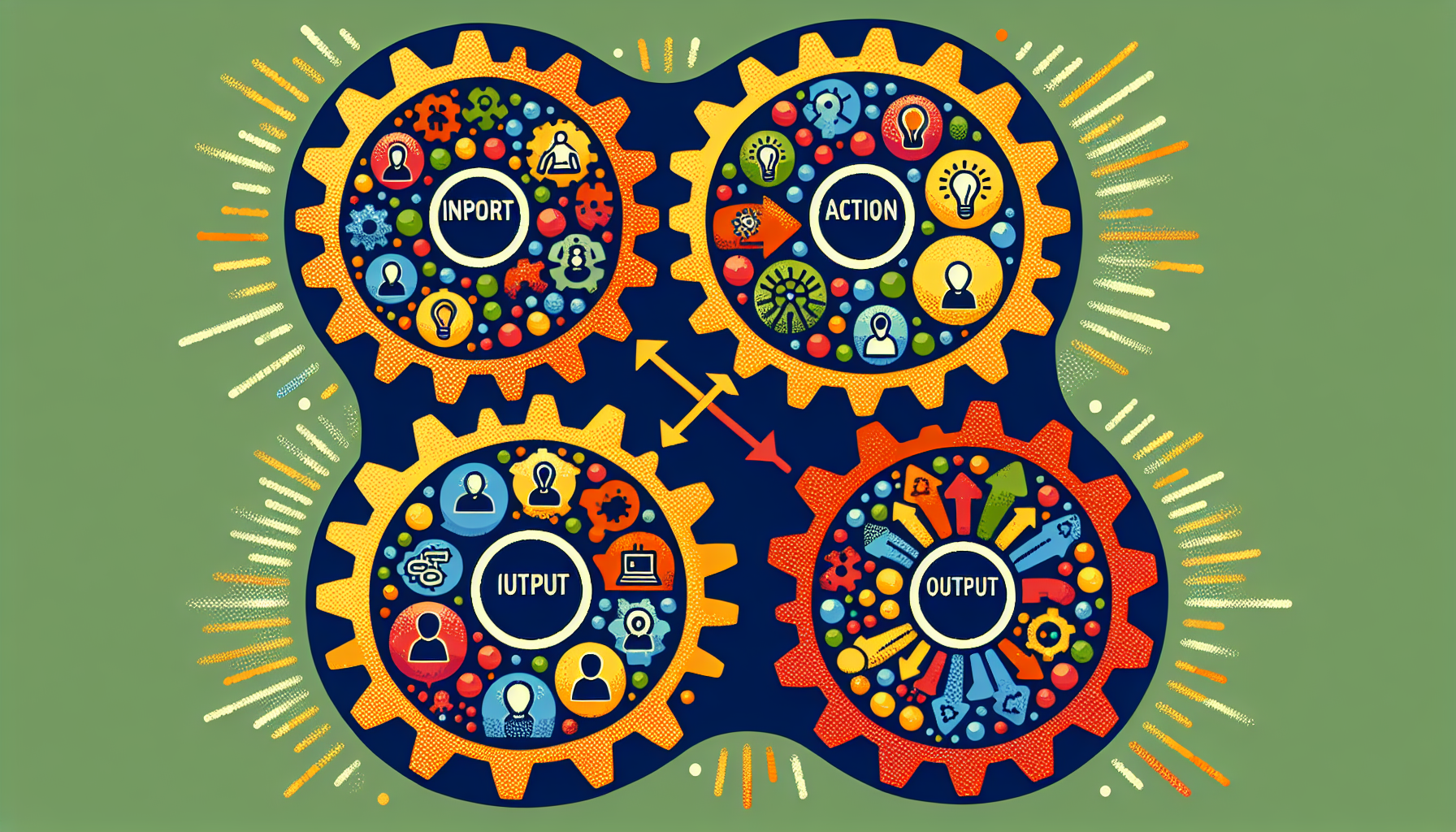Unlock Explosive Growth: The Small Business Owner's Guide to Mastering Growth Loops
Feb 09, 2024
Struggling to grow your small business without just pouring more money into ads? Growth loops might be the game-changer you need. This revolutionary approach turns customers’ interactions into a growth engine, cutting down on ad budgets and scaling your business efficiently. Dive into our guide to learn how growth loops can elevate your business, with practical steps and real-world examples to get you started.
Key Takeaways
-
Growth loops are self-sustaining cyclical models that drive exponential growth, overtaking traditional linear growth strategies by continuously integrating user acquisition, engagement, and monetization.
-
Successful growth loop implementation requires identifying core value propositions, mapping out customer journeys for growth loops, and constantly evolving the offering based on market and customer feedback.
-
Real-world success stories from companies like SurveyMonkey, Venmo, YouTube, and LinkedIn illustrate the effectiveness of growth loops, which depend on user actions and engagements to foster sustainable, user-centric business expansion.
Demystifying Growth Loops: The Engine of Sustainable Growth

Instead of simply being a fad, growth loops signify an evolution in the approach to growing businesses. These loops break away from the conventional straight-line models and adopt a recursive process that fuels its advancement. Picture it as similar to how a snowball gains size and speed while descending a hill, this vividly illustrates what occurs during the execution of a growth loop strategy. By adopting such frameworks, companies can exploit these self-reinforcing cycles for their continual development.
Growth loop instances are seen in strategies where earned revenue is funneled back into acquiring more users or when teams collaborate seamlessly to drive continuous momentum within these cycles. For effective implementation of growth loops, one must weave them throughout each stage of the customer experience. This practice known as ‘growth stacking’ has the potential to result in exponential amplification.
The Core Components of a Growth Loop

At the heart of each growth loop are three essential components: input, action, and output. The initial phase is dedicated to drawing in new users by employing strategies like focused advertising efforts and robust social media initiatives.
During the action phase, value is generated through user engagement with the product or service for the first time or when they delve into additional offerings or functionalities, resulting in heightened satisfaction levels.
Subsequently, as an outcome of these engagements comes expansion. Satisfied existing users tend to naturally promote user base growth by attracting more individuals and broadening product reach. This cycle’s culmination feeds back into its starting point—input—which assists not just in perpetuating this continuous loop, but also plays a critical role in revenue generation.
The Viral Loop: Word of Mouth Amplified

One of the most potent types of growth loops is the viral loop, which magnifies word-of-mouth promotion via advocacy from customers, prospects, and employees. Notable companies such as Tesla, Robinhood, PayPal, and Dropbox have harnessed a variety of viral loop tactics that reward referrals to propel their user growth and acquisition.
The architecture of a product is vital in fostering viral loops. For example, Calendly’s freemium offering incentivizes widespread sharing. Similarly, Notion’s design encourages increasing use with its scalability while Loom integrates an embedded looping mechanism within its platform. These strategies enhance sharing and invitations thus feeding into cyclical growth loops that boost ongoing participation—taking word-of-mouth marketing much more than what could be achieved through traditional advertising methods.
The Role of Technology in Enhancing Growth Loops
Incorporating modern technology into growth loops diminishes reliance on traditional advertising and agencies, enabling a shift towards a more customer-focused growth model. Technologies such as referral platforms, contest software, and social media engagement tools are instrumental in simplifying the user experience and fostering engagement, which in turn supports growth loops.
Platforms such as Loom and Canva use technology to deliver contextual messages and personalized dashboards that encourage users to engage and move towards premium offerings, supporting the revenue component of growth loops. These technological enhancements not only streamline customer interactions but also offer personalized experiences to new and returning users, which are essential for maintaining virality and retention in growth loops.
Crafting Your Company's Growth Loop Model

Establishing a successful, lasting growth loop is not a one-size-fits-all endeavor. It requires an in-depth grasp of your unique business and its distinct qualities. Beginning with pinpointing the fundamental value proposition of your product, it’s crucial to continually refine elements within the loop for sustained exponential expansion. This process forms a robust engine that propels sustainable growth within your company.
Integrating growth loops from the early stages into your product or service aligns seamlessly with both user experience and prevailing market dynamics. To effectively implement these loops, organizations can:
-
Pinpoint essential interactions along the customer journey
-
Select a singular type of growth loop for concentration
-
Cultivate a particular user demographic
-
Encourage those users towards behaviors that Drive the momentum of the loop
This strategic framework for modeling growth loops applies across various businesses and industries, offering versatile utilization potential for any organization seeking progression.
Identifying Your Unique Value Proposition for Growth
Developing a distinct value proposition goes beyond just itemizing the attributes of your product or service. It requires an in-depth grasp of what your customers require and the distinguishing aspects that set your offering apart. Your value proposition must underscore the value as perceived by customers, employing terminology that reflects their way of discussing the problems solved by your product.
To tailor marketing efforts effectively, companies can adopt various approaches such as:
-
Examining user-profiles and historical buying patterns
-
Integrating insights gained from customer evaluations
-
Aligning sales tactics with what consumers favor
Utilizing these methods enables organizations to enhance not only the attraction of new clients but also foster loyalty amongst existing ones.
Mapping the Customer Journey Through Growth Loops
The trajectory of the customer through your growth loop weaves a storyline that melds their experiences with your brand identity. A graphical representation called a customer journey map delineates every interaction between a consumer and the company, tracing from first contact to after-sales service. Plotting these touchpoints along with possible responses shaped by customer choices is essential in crafting this narrative.
To maintain relevance, these maps must undergo periodic revisions which entail:
-
Updating current points of engagement,
-
Strategically planning forthcoming interactions,
-
Embedding ordinary practices and particulars concerning service provision.
Integrating product development, marketing tactics, and revenue models into unified growth loops forms an effective network that stimulates perpetual business expansion while fine-tuning each step of the client’s path toward higher involvement and increased sales conversions.
Real-World Applications: Successful Growth Loops in Action

Now, let’s shift from theory to real-world applications. Businesses across various industries have successfully implemented growth loops, leveraging user actions and content sharing to drive sustainable, user-centric growth. From SurveyMonkey’s viral loop that engages users through the creation and sharing of surveys to Venmo’s growth loop that makes peer-to-peer payments both easy and social, these stories of success demonstrate the immense potential growth loops offer.
Examples continue with:
-
YouTube, enables creators to share videos externally, and viewers to engage with content and enter the creator loop themselves, perpetuating platform growth.
-
LinkedIn uses a growth loop that encourages users to sync contact lists, connect with others, and invite more contacts, continuously expanding its network.
-
TikTok, whose content-driven loop thrives on users sharing short videos, which are then amplified on social media, drawing in new content creators.
These real-world applications showcase the power of growth loops in action, providing tangible examples for businesses looking to implement their growth loop strategies.
Case Study: Leveraging User Generated Content
A prime example showcasing the effectiveness of growth loops can be seen in Pinterest’s utilization of its User Generated Content (UGC) loop. This mechanism allows users to produce and share pins, which search engines subsequently index, naturally drawing more traffic to the site. The creation by users acts as a dual-purpose tool: it boosts acquisition through increased visibility and serves as an engagement tool that offers worthwhile content to maintain interest among current users.
By incorporating rewards schemes and incentives for referrals after purchases – like providing extra services or price reductions – companies encourage their user base to generate more content. Such strategies not only enhance the volume of User Generated Content but also significantly amplify both user expansion and active participation on platforms.
Case Study: Product-Led Strategies That Drive Growth
PLG approaches prioritize:
-
The perpetual enhancement of the product is a critical force behind the increase in user base and revenue growth
-
Utilizing AI and ML algorithms to automate how resources are distributed and forecast customer needs
-
Boosting both efficiency and the user’s interaction with the product
Employing recommendation systems allows companies to deliver tailor-made suggestions, which bolsters users’ experiences while also heightening their involvement and boosting sales figures. Concentrating on refining products aligns seamlessly with growth loop concepts, fostering lasting expansion that centers around the consumer.
Overcoming Obstacles: Building Growth Loops That Last
Navigating the difficulties involved in establishing a successful growth loop is essential for ensuring these loops generate consistent and long-term expansion. A key hurdle includes keeping customers engaged during their experience, which helps to avoid user attrition and contributes to the ongoing success of growth loops. Adapting one’s value proposition based on shifts in market dynamics and customer insights is equally important to ensure that it remains relevant and meets community demands.
Gauging whether a growth loop meets its objectives requires continuous performance assessment. When traditional ROI calculations indicate that costs surpass generated revenue, this signifies the failure of the growth loop. It’s imperative to refine current practices while also seeking fresh incentive strategies that create mutual benefits for users—this fuels active engagement within these pivotal drivers of company advancement.
Balancing Acquisition and Retention in Growth Loops
Creating a successful growth loop requires striking a balance between attracting new customers and keeping existing ones engaged. Retaining customers is not only cost-effective, but it also propels sustainable growth within the growth loops as these loyal consumers tend to spend more and often recommend your product to others. To reinforce retention in the cycle of growth, one should utilize built-in triggers that promote continued user interaction while concurrently reducing attrition rates—solidifying the strength of customer retention within the loop.
For growth loops to thrive with equilibrium, there must be an evenly distributed focus on resource allocation aimed at preserving current customer relationships alongside drawing in fresh clientele. By refining channels that can efficiently support both ends—customer acquisition and upkeep—an ideal approach towards perpetual motion within the market’s dynamics is established.
Integrating Sales Efforts with Growth Loops
Incorporating marketing and sales initiatives into growth loops requires the harmonization of sales motivations and tactics with the fundamental dynamics powering these loops. The active involvement of sales personnel is essential, as their understanding of both product intricacies and consumer behavior is key to tailoring the sales process appropriately for compatibility with a growth loop structure.
Through digital platforms, companies are capable of:
-
Initiating precise advertising efforts
-
Enhancing user onboarding procedures to efficiently attract and maintain new users
-
Employing growth loops strategically to restructure marketing teams’ approaches toward utilizing customer data in demand creation, thus surpassing conventional funnel limitations.
The Evolution of Marketing: From Funnels to Loops
Throughout the history of marketing, there has been a significant transformation in strategies, with growth loops marking a pivotal transition from traditional linear funnel approaches to circular models that emphasize both compounding growth and sustained customer engagement. The classic view of funnels suggests customers follow a straight path ending at purchase or acquisition. This perspective does not account for ongoing interactions and value exchange between consumers and companies.
Growth loops diverge from this by employing a circular approach that generates repeat opportunities for events and engagements—this enhances possibilities for exponential growth. Unlike one-way conduits toward conversion depicted by funnels, growth loops embrace the reality of user behavior being multi-directional and dynamic. Because they work through recursive dependencies rather than single steps, they magnify efficiencies in driving business expansion beyond what is achievable via traditional funnel methodologies.
Why Growth Loops Matter More Than Ever
In today’s climate, where trust in conventional media and advertisements is declining, the importance of growth loops has reached unprecedented levels. Recommendations passed on through word of mouth are growing in relevance, necessitating novel strategies for expansion that focus on promoting customer advocacy and fostering organic growth.
Transitioning from a traditional funnel-focused model to one centered around loop-centric growth strategies is essential. This shift provides a more comprehensive perspective of the entire customer journey, harmonizing new customer acquisition with sustained retention efforts.
Transitioning from Funnel to Loop: A Strategic Approach
Shifting from a funnel approach to adopting a growth loop represents not just an adjustment in tactics, but also a fundamental change in perspective. These growth loops must become intertwined with the traditional marketing funnel, evolving what were once linear campaigns into sustainable cycles of user engagement and referrals. By centering their strategy around growth loops, companies can make use of rich customer insights to constantly refine and transform user experiences into products themselves—creating a self-perpetuating engine for expansion that reduces dependence on standard advertising methods.
Within the stages of awareness, consideration, and desire within the funnel framework, businesses can strategically implement growth loops through tactics like shareable incentives, email rewards tied to referrals or more compelling demos or trial periods designed to turn interested parties into active promoters. This strategic evolution progresses beyond transaction-focused operations towards nurturing recurring relationships—an outlook that promises ongoing interaction with users while driving perpetual organizational advancement.
Summary
Growth loops represent a significant shift in the way businesses approach growth. By reinvesting outputs as inputs in a continuous cycle, growth loops provide a self-sustaining engine for sustainable and compounded growth. They offer a strategic competitive edge that is difficult to copy, making them a valuable tool for businesses of all sizes and industries.
From understanding the core components of a growth loop to seeing them in action through real-world applications, we’ve explored the transformative power of growth loops. These self-perpetuating systems offer a strategic approach to driving sustainable growth, creating a snowball effect of continuous user engagement and revenue expansion. As the marketing landscape evolves, growth loops stand as a testament to the power of customer-centric, cyclical growth strategies over traditional linear models.
Frequently Asked Questions
What are growth loops?
In closed systems known as growth loops, there is a cyclical process wherein inputs undergo multiple stages to generate an output that is subsequently rechanneled back into the system to start the cycle anew.
Which of the following are examples of growth loops?
Start-ups utilize growth strategies such as product-led growth, viral marketing, and user referrals to continuously attract and retain users, aiding in steady user acquisition.
What is the difference between growth loops and funnels?
To sum up, growth loops facilitate a cyclical process that maintains organic expansion on its own, in contrast to funnels which adhere to a step-by-step progression for acquiring new users.
What is an example of a viral growth loop?
Dropbox exemplifies a fundamental viral loop by offering incentives to existing users who promote the product among their friends, thus spurring on its viral expansion.
How can a business implement a growth loop?
A company aiming to establish a growth loop must pinpoint essential touchpoints along the customer journey, concentrate on developing a single type of growth loop, construct a targeted user segment, and encourage them to engage in behaviors that propel the growth loop’s momentum.
Transform Your Business into a Golden Goose
Create a perpetual growth machine by transforming your customers into a marketing army! Sign up today to get a sneak peek of our revolutionary marketing course.


